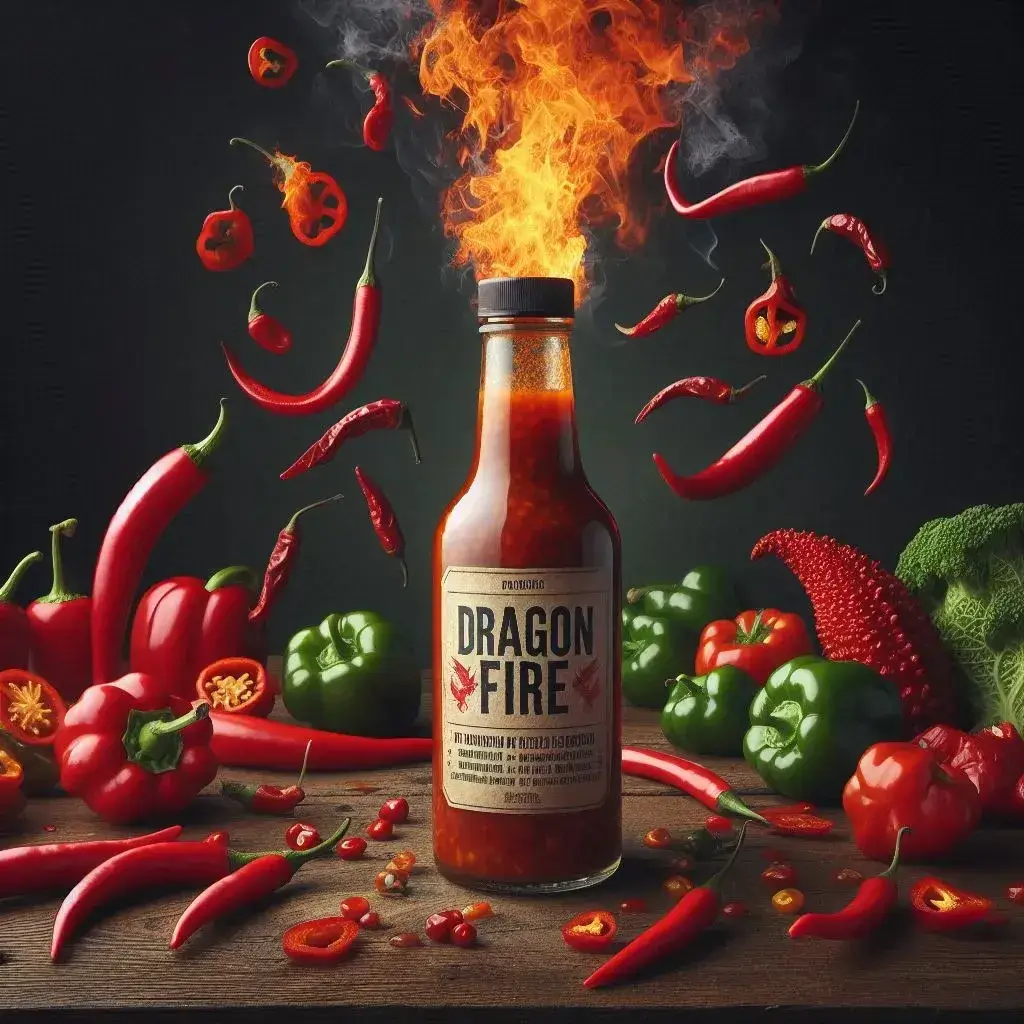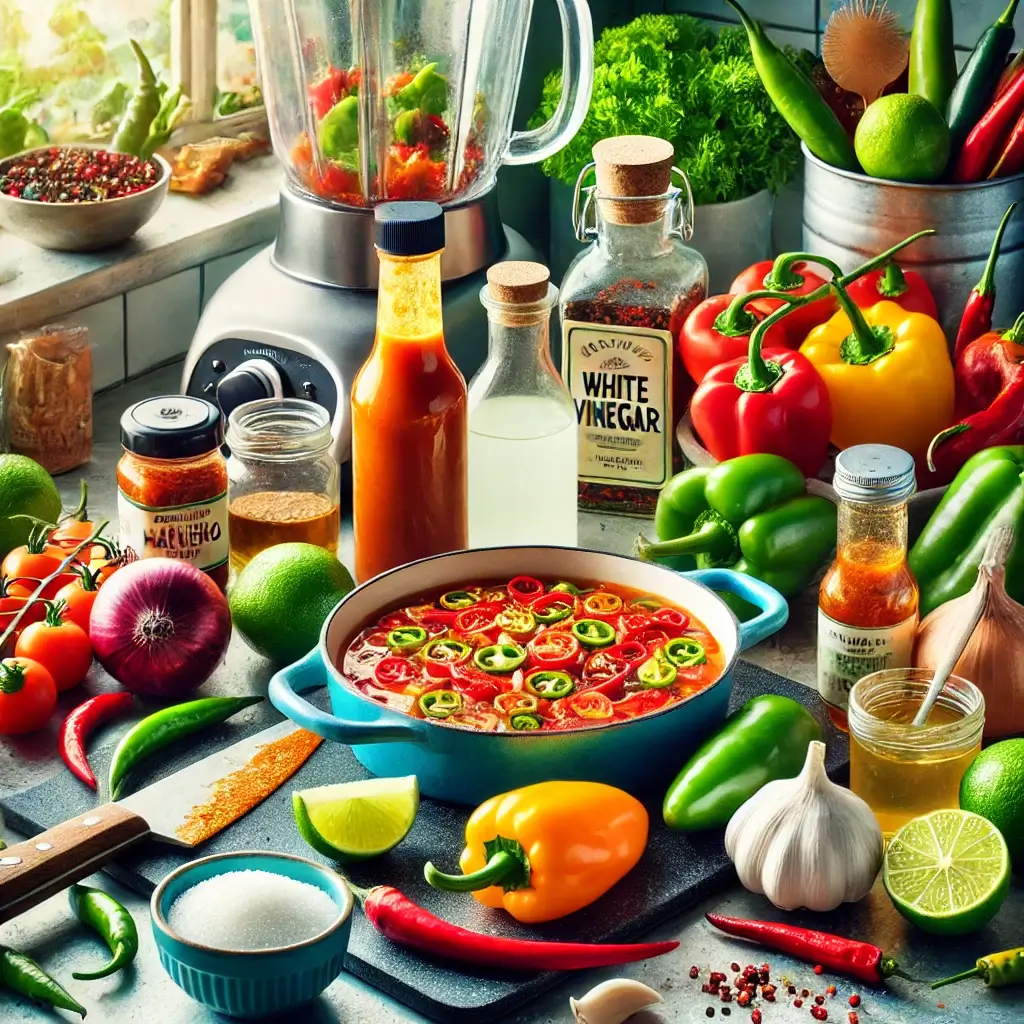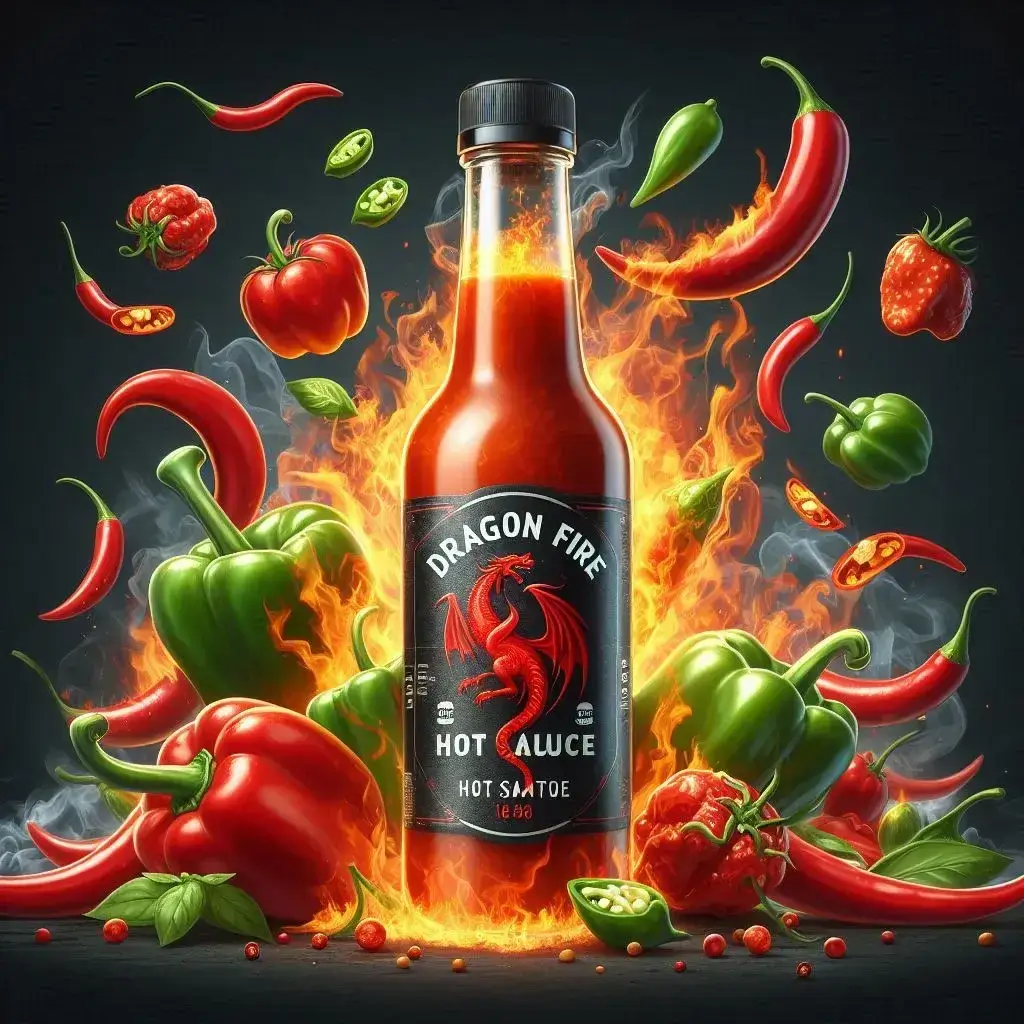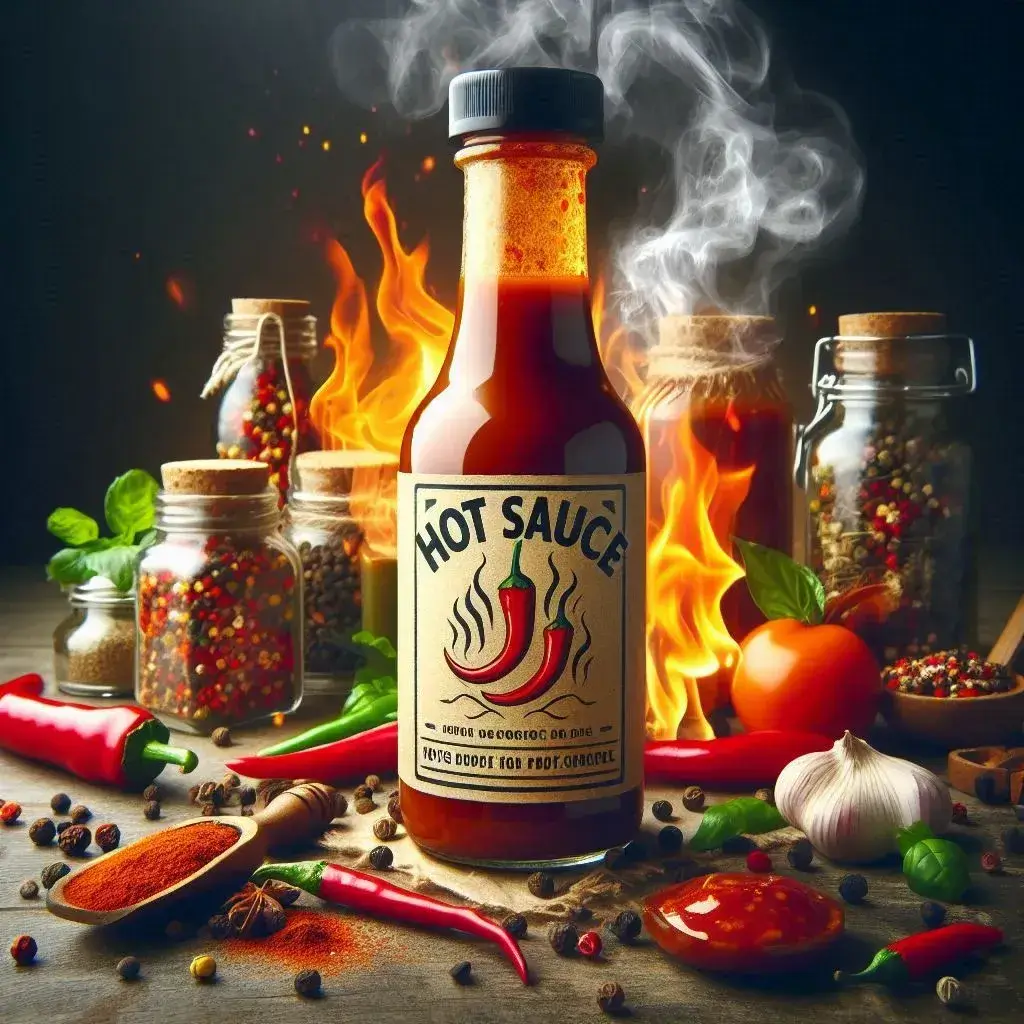- 100 Best Energy Drink Ultimate 2025 Guide - 08/16/2025
- Twisted Tea: The Ultimate 2025 Guide(Kept up to date) - 08/13/2025
- 100 Best Eat & Drink Ultimate 2025 Global List - 08/11/2025

Table of Contents
Crafting the best hot sauce at home is a culinary adventure that combines the right balance of heat, flavor, and consistency. Whether you’re a seasoned spice enthusiast or just starting to explore the world of heat, this recipe offers a versatile, flavorful sauce that can elevate any dish, from tacos and wings to eggs and even cocktails. Here’s how to create a hot sauce that’s bursting with flavor, easy to make, and customizable to your heat tolerance.
Ingredients:
- Chili Peppers (1 lb): The core ingredient for any hot sauce. The type of chili pepper you choose will determine the heat level. For a milder sauce, opt for jalapeños or Fresno peppers. If you want something fiery, try habaneros or Scotch bonnets. A mix of different peppers can add complexity and depth to the sauce.
- Garlic (4 cloves): Garlic adds a savory depth and rounds out the sharpness of the peppers, making the sauce more balanced.
- Onion (1 medium): A medium onion provides sweetness and a slight pungency that complements the peppers.
- White Vinegar (1 cup): Vinegar not only adds acidity but also acts as a preservative, ensuring your hot sauce has a long shelf life.
- Lime Juice (Juice of 2 limes): Lime juice adds a fresh, tangy note that brightens up the sauce.
- Salt (1 tsp): Essential for enhancing flavors and bringing out the best in your ingredients.
- Sugar (1 tbsp): A small amount of sugar balances the acidity and heat, creating a more rounded flavor.
- Water (as needed): Used to adjust the consistency of the sauce.
- Optional Spices: Cumin, smoked paprika, or coriander can add an extra layer of flavor to the sauce.
Instructions:
1. Preparation:
Begin by washing and drying your chili peppers. Depending on your heat preference, you can remove the seeds and membranes, which hold most of the heat, or leave them in for a spicier sauce. Chop the peppers into small pieces. Prepare the garlic and onion by peeling and chopping them finely.
2. Sautéing the Base:
Heat a tablespoon of oil in a medium saucepan over medium heat. Add the chopped garlic and onion, sautéing until they are soft and translucent, about 5 minutes. This step mellows the sharpness of the onion and garlic, making them a perfect base for the sauce.
3. Cooking the Peppers:
Add the chopped chili peppers to the saucepan, stirring to combine with the garlic and onion. Cook for another 5 minutes until the peppers start to soften. This cooking process releases the essential oils from the peppers, intensifying their flavor and heat.
4. Simmering:
Pour in the white vinegar and lime juice, then add the salt and sugar. Stir everything together and bring the mixture to a boil. Once boiling, reduce the heat to low and let it simmer for 15-20 minutes. This allows the flavors to meld and the peppers to soften further. If the sauce thickens too much, add a little water to reach your desired consistency.
5. Blending:
Once the mixture has simmered and is fully cooked, carefully transfer it to a blender or food processor. Blend until smooth. If you prefer a chunkier sauce, pulse the blender until you achieve the desired texture. For a completely smooth sauce, you can strain it through a fine-mesh sieve to remove any remaining solids.
6. Tasting and Adjusting:
Taste your hot sauce and adjust the seasoning as needed. If it’s too acidic, add a bit more sugar. If it’s not salty enough, add a pinch more salt. You can also add more lime juice or vinegar if you like your sauce tangier.
7. Bottling and Storing:
Once you’re satisfied with the flavor, let the sauce cool to room temperature. Pour it into sterilized glass bottles or jars. Properly sterilizing the containers is crucial for preserving the sauce. Store your hot sauce in the refrigerator, where it will keep for up to six months.
Variations:
- Fermented Hot Sauce: For a more complex flavor, try fermenting the chili peppers before making the sauce. This involves leaving the chopped peppers in a saltwater brine at room temperature for several days. Fermentation adds a tangy, umami-rich note that’s hard to achieve with fresh peppers alone.
- Smoked Peppers: If you enjoy a smoky flavor, use smoked peppers like chipotle, or smoke the fresh peppers before cooking. This variation works particularly well with grilled meats and barbecue.
- Sweet and Spicy: Add fruits like mango, pineapple, or peach for a sweet and spicy hot sauce. The natural sweetness of the fruit pairs beautifully with the heat from the peppers, creating a sauce that’s perfect for glazing chicken or adding to tropical salsas.
Tips for Success:
- Use Fresh Ingredients: The fresher the ingredients, the better the flavor. Try to use peppers, garlic, and onions that are at their peak for the best results.
- Handle with Care: When handling hot peppers, it’s a good idea to wear gloves to avoid irritation. The oils from the peppers can be very strong and difficult to wash off, so avoid touching your face, especially your eyes.
- Experiment: Don’t be afraid to experiment with different types of peppers, vinegars, and additional flavorings. Making hot sauce is an art, and part of the fun is customizing it to your taste.


Conclusion:
Creating your own hot sauce at home is not only fun but also allows you to customize the heat and flavor to your liking. Whether you prefer a fiery kick or a milder heat with a hint of sweetness, this recipe provides a solid foundation for your hot sauce adventures. The next time you’re looking to spice up a dish, reach for your homemade sauce and enjoy the fruits of your labor. With a little experimentation, you might just discover your new favorite condiment.
Best Seasonings for Elevating Your Cooking(12 types)
Amazon Best Sellers in Home & Kitchen: Top 10 Must-Have Products for Your Home 2025
Need to spruce up your home without the hassle? Amazon's got the goods - from game-changing kitchen gadgets to cozy bedding that'll make you never want to leave your house. The best part? These picks aren't just popular, they're actually worth your hard-earned cash (with thousands of happy customers backing them up).
We're breaking down:
🏆 The 10 home & kitchen essentials everyone's buying
⭐ Real-deal reviews from people who actually use this stuff
🔗 Easy links so you can grab 'em quick
No fluff - just the home upgrades that deliver. Let's check out what's worth adding to your cart!
1. Owala FreeSip Insulated Stainless Steel Water Bottle
🚀 Why it’s a Best Seller: A leak-proof, insulated bottle with a unique FreeSip design—perfect for on-the-go hydration!
Key Features:
- 24 oz capacity – Great for sports, travel, and daily hydration.
- Innovative FreeSip spout – Allows for sipping upright through the built-in straw or tilting back for chugging.
- Double-wall insulation – Keeps drinks cold for up to 24 hours.
- BPA-free and dishwasher safe – Safe and easy to clean.
Why Customers Love It:
✅ Durable & stylish – The Denim color is sleek, and the stainless steel construction is built to last.
✅ Great for travel – Leak-proof lid prevents spills in bags.
✅ Comfortable to hold – The ergonomic design makes it easy to carry.
⭐ Rated 4.8/5 on Amazon with thousands of reviews!
2. Stanley Quencher H2.0 Tumbler with Handle & Straw
🔥 Why it’s a Best Seller: The viral Stanley tumbler is a hydration game-changer with a 30 oz capacity and ergonomic handle!
Key Features:
- FlowState 3-position lid – Prevents spills and allows easy drinking.
- Double-wall vacuum insulation – Keeps drinks cold for up to 11 hours and ice cold for 2 days.
- Comfort grip handle – Perfect for carrying around.
- Fits in car cup holders – Designed for easy travel.
Why Customers Love It:
✅ Trendy and practical – Available in multiple colors, including the beautiful Peony shade.
✅ Large capacity – Holds enough water for a full day.
✅ Keeps drinks cold for hours – Ideal for hot summer days!
⭐ Over 50,000 reviews and a 4.9/5 rating!
3. TERRO T300B Indoor Liquid Ant Killer
🐜 Why it’s a Best Seller: Say goodbye to ant infestations with this highly effective liquid ant bait.
Key Features:
- Pre-filled bait stations – Easy to use and mess-free.
- Targets the entire colony – Not just the ants you see.
- Works within days – Quickly eliminates ant infestations.
Why Customers Love It:
✅ Highly effective – Works on various ant species.
✅ Safe for indoor use – No strong chemical smells.
✅ Affordable & long-lasting – Comes with 12 bait stations!
⭐ 4.7/5 stars with 70,000+ reviews!
4. Queen Size 4-Piece Sheet Set - Hotel Luxury Bedding
🛏️ Why it’s a Best Seller: Ultra-soft, breathable, and wrinkle-free hotel-quality bed sheets!
Key Features:
- Deep pockets – Stays securely on mattresses.
- Soft & breathable – Made from high-quality microfiber.
- Wrinkle-free & easy care – Machine washable.
- Oeko-Tex Certified – Safe and eco-friendly materials.
Why Customers Love It:
✅ Super soft & luxurious – Feels like a 5-star hotel.
✅ Perfect fit – Stays in place on all mattress sizes.
✅ Easy to maintain – No ironing needed!
⭐ 4.6/5 stars and a customer favorite!
5. upsimples 8x10 Picture Frame
🖼️ Why it’s a Best Seller: A sleek, modern photo frame that enhances any home decor.
Key Features:
- Two display options – 5x7 with mat or 8x10 without mat.
- Wall-mounted & tabletop display – Versatile design.
- Durable & stylish – Black frame suits any decor.
Why Customers Love It:
✅ Lightweight & easy to hang
✅ Protects photos with HD plastic cover
✅ Affordable & stylish home decor
⭐ 4.5/5 rating from thousands of happy buyers!
6. Zevo Flying Insect Trap & Cartridge
🦟 Why it’s a Best Seller: A plug-in, mess-free indoor bug trap that uses blue & UV light to attract and eliminate flying insects.
Key Features:
- Attracts & traps gnats, house flies, and fruit flies – No chemicals or sprays needed.
- Uses blue & UV light technology – Scientifically designed to lure insects.
- Mess-free & odor-free – No dead bug clean-up.
- Compact and stylish – Fits seamlessly in any room.
Why Customers Love It:
✅ Works effectively indoors – Perfect for kitchens, bedrooms, and living areas.
✅ No harmful chemicals – Safe for homes with kids and pets.
✅ Replaceable cartridges – Easy to maintain for long-term use.
⭐ Rated 4.6/5 with thousands of positive reviews!
7. Utopia Bedding Queen Bed Sheets Set
🛏️ Why it’s a Best Seller: Soft, shrink-resistant, and easy-care microfiber sheets that feel as luxurious as high-end hotel bedding.
Key Features:
- Includes 4 pieces – 1 flat sheet, 1 fitted sheet, and 2 pillowcases.
- Brushed microfiber fabric – Ultra-soft and breathable.
- Fade & shrink resistant – Maintains its quality after multiple washes.
- Deep pockets & secure fit – Fits mattresses up to 16 inches thick.
Why Customers Love It:
✅ Super soft and comfortable – Perfect for all seasons.
✅ Easy to wash & maintain – Machine washable and wrinkle-free.
✅ Affordable luxury – Feels expensive without the high price tag.
⭐ 4.6/5 rating from over 100,000 buyers!
8. Barossa Design Plastic Shower Liner
🚿 Why it’s a Best Seller: A premium waterproof shower liner that keeps your bathroom dry and stylish.
Key Features:
- Made from PEVA material – Non-toxic and environmentally friendly.
- Waterproof & mildew-resistant – Prevents mold and soap scum buildup.
- Rustproof grommets & 3 magnets – Provides extra stability and durability.
- Fits standard-size showers – Lightweight and easy to install.
Why Customers Love It:
✅ Clear, minimalist design – Blends well with any bathroom decor.
✅ Durable & long-lasting – Resistant to wear and tear.
✅ Easy to clean – Simply wipe or rinse to maintain freshness.
⭐ 4.7/5 stars and a top-rated shower liner!
9. Utopia Bedding Throw Pillow Inserts (Pack of 2)
🛋️ Why it’s a Best Seller: Fluffy, soft, and supportive throw pillows that enhance the comfort and look of your couch, bed, or chairs.
Key Features:
- Comes in a set of two – Perfect for pairing on sofas or beds.
- 18 x 18 inches size – Ideal for standard throw pillow covers.
- High-quality polyester filling – Provides plush support.
- Durable and breathable – Keeps shape over time.
Why Customers Love It:
✅ Soft and supportive – Adds a cozy feel to any space.
✅ Perfect for decorating – Works well with various pillow covers.
✅ Easy to maintain – Machine washable for convenience.
⭐ 4.5/5 rating from thousands of happy customers!
10. Utopia Bedding Waterproof Mattress Protector
🛌 Why it’s a Best Seller: A breathable, waterproof mattress cover that protects against spills, allergens, and dust mites.
Key Features:
- 100% waterproof protection – Shields against spills, sweat, and stains.
- Soft terry cloth top layer – Feels comfortable and breathable.
- Fitted design with stretchable pockets – Stays securely in place.
- Hypoallergenic material – Great for allergy sufferers.
Why Customers Love It:
✅ Protects your mattress investment – Extends mattress lifespan.
✅ Doesn’t change mattress feel – Comfortable and silent.
✅ Easy to clean – Machine washable for hassle-free maintenance.
⭐ Rated 4.7/5 by satisfied customers!
Final Thoughts: Upgrade Your Home Today!
These home essentials are bestsellers for good reason - they actually work, look great, and make life easier. Whether you're after:
• The perfect water bottle
• Stylish decor that doesn't break the bank
• Bedding you'll want to live in
• Pest solutions that really work
...thousands of shoppers swear by these picks.
👉 Tap those links to give your home an instant upgrade!
So what's going in your cart first? Drop us a comment below - we want to know!
✅ Pro Tip: Want the hottest Amazon finds? Save this page and come back for fresh picks!
🔥 Smart shopping = Better living 🔥
🎯 Don’t Miss Out — These Are Reader-Favorite Bestsellers You’ll Love Too 👇
| # | 🎁 Product | 💬 Why It Converts | 🔗 Quick Action |
|---|---|---|---|
| ✅ 1 | Exploding KittensThe Wildly Popular Card Game | 🔥 100,000+ rave reviews🤣 Fun for all ages🎉 #1 party game choice | 👉 Click to Check Price |
| 😂 2 | Funny Dad T-Shirt“You Can’t Scare Me, I Have Kids” | 👕 Viral dad gift🎂 Perfect for birthdays & Father’s Day💬 Gets people laughing instantly | 👉 See It in Action |
| 🕯️ 3 | Luxury Candle Gift SetElegant 1-Wick, Spa Fragrance | 🧘♀️ Instant relaxation🎁 Beautifully boxed for gifting💡 Affordable luxury | 👉 Treat Yourself or Gift Now |
| 🔍 4 | Tile Bluetooth TrackerFind Anything in Seconds | 🛠️ Life-saving tech🧓 Great for parents, teens, travelers📱 Works with your phone | 👉 Never Lose Anything Again |
| 📘 5 | Atomic Habits by James ClearTransform Your Daily Life | 📖 20M+ readers worldwide🔑 Simple steps, big results🎓 Top self-growth book | 👉 Read What Everyone’s Talking About |
✅ Why These Items Sell:
| 💡 Trigger | Example in Table | How It Helps Conversion |
|---|---|---|
| ✅ Social Proof | “100,000+ rave reviews” | Builds trust instantly |
| 🎯 Use Case Clarity | “Great for family game night” | Reduces decision friction |
| 🚀 Action Verbs | “Click to check price” | Encourages immediate action |
| 🔥 Urgency & Emotion | “Don’t miss out” / “Treat yourself” | Triggers impulse buying |
| 🎁 Gifting Potential | “Perfect for birthdays & holidays” | Taps into universal purchase intent |
❤️ Your Click Makes a Difference
Every purchase made through these links helps support this site and keeps great content coming — Thanks!
💬 Why Tip? It’s Not Just Money — It’s Motivation ❤️
| 😊 What You Got | 🎁 What I Get | 🔗 What You Can Do |
|---|---|---|
| ✔️ A smile or laugh | ✔️ A reason to keep creating | 👉 Buy me a coffee ☕️ |
| ✔️ Useful tips, insights, or ideas | ✔️ Proof that this content helps | 👉 Click the support button 💸 |
| ✔️ Fun, relatable content | ✔️ Motivation to go deeper & better | 👉 Leave a tip + kind feedback 🙌 |
| ✔️ Ad-free reading experience | ✔️ A little financial breathing room | 👉 $1 isn’t too little, $10 isn’t too much 🎉 |
| ✔️ A sense of connection | ✔️ The joy of being seen and supported | 👉 Let me know you’re out there 👀 |
❤️ If you made it this far, maybe that’s your sign to support? Every tip matters!

